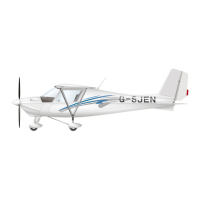
Do you have a question about the iKarus C 42 Series and is the answer not in the manual?
| Crew | 1 |
|---|---|
| Capacity | 1 passenger |
| Rate of climb | 5 m/s (980 ft/min) |
| Model | C 42 |
| Accommodation | 2 (pilot and passenger) |
| Engine | Rotax 912 |
| Powerplant | Rotax 912 UL or ULS |
| Stall speed | 64 km/h (40 mph, 35 kts) |
| Never exceed speed | 140 mph |
| Service ceiling | 4, 000 m (13, 000 ft) |
Details critical airspeeds like Vne, Vb, Va, Vfe, and stall speeds for different flap positions.
Specifies maximum take-off weight, with/without rescue system, empty weight, and minimum payload.
Defines positive and negative limit load factors for structural integrity.
Outlines the reference datum and forward/rearward CG limits for safe operation.
Explains the colors and lines on the airspeed indicator for different speed ranges.
Specifies maximum engine RPM for take-off and continuous operation.
Describes the yellow and red arcs on the RPM indicator.
Details the flap positions and their associated flight phases (cruising, take-off/landing).
Lists approved propellers for Rotax 912 UL engines with specifications.
Lists approved propellers for Rotax 912 ULS engines with specifications.
Covers engine limits, oil/fuel specs, temperatures, and pressures for Rotax 912/912S.
Explains nose wheel steering, turning radius, and handling crosswinds during taxiing.
Details pre-takeoff checks, trim settings, flap use, and initial climb procedures.
Provides economical cruise speeds, engine performance, and trimming for horizontal flight.
Describes coordinated turns using ailerons and rudders and the effect of airspeed.
Explains stalling speeds in different flap configurations and recovery procedures.
Covers approach procedures, flap use, speeds for final approach, and rounding out.
Outlines the procedure for shutting down the engine after landing.
Provides procedures for engine failure during takeoff and cruising flight.
Details how to adjust the cowl flap for engine temperature control.
Covers procedures for tipping, sideslip, spin, spiral dive, and loss of control surfaces.
Explains manual moving using tail struts and pivoting on main wheels.
Describes lifting the aircraft with a hoist using designated mounting points.
Lists factors for parking, including brake application and securing the aircraft.
Details procedures for securing the aircraft outdoors using ropes and anchors.
Provides a template for calculating weight and balance, including CG limits.
Lists approved Rotax engines and compatible propeller models.
Lists approved parachute rescue systems and associated safety notes.
Covers fuel tank capacities, electrical flap drive, and electrical trim.
Provides take-off distances and speeds for Rotax 912 UL and ULS engines.
Details rate of climb and best rate speed for Rotax 912 UL and ULS engines.
Lists cruising speeds at 65% power for different aircraft models and engines.
Gives data for engine-off performance, including sink rate and glide angle.
Step-by-step instructions for attaching wings to the fuselage.
Instructions for folding wings for storage or hangaring.
Checks for the engine, including propeller, cowling, fluids, and vents.
Inspection points for landing gear, including tires and shock absorbers.
Inspection checks for the left wing, including spar connections, struts, and control surfaces.
Checks for the left fuselage fairing, baggage hatch, and internal connections.
Inspection of the tail surfaces, including stabilizer, rudder, and control connections.
Checks for the right fuselage fairing and fuel tank cap.
Refers to inspection points for the left wing.
Checks the cabin condition, windscreen, and doors.
Checks for power supply, altimeter setting, fuel quantity, and radio.
Instructions for fuel tank drainage.
Guidelines for cleaning aircraft metal parts, fabric, and glazing.
States that maintenance must be performed by qualified persons.
Notes that repairs and major changes require reporting and inspection.
Covers airworthiness inspections by manufacturer or DAeC inspectors.
Limits repairs to part exchange and use of original spare parts.
Details periodical inspections (50/100 hr) and required manuals.
Specifies reporting procedures for technical problems or defects.
Defines incidence angle measurement for the wing relative to the main tube.
Defines incidence angle measurement for the stabilizer relative to the main tube.
Specifies the difference between wing and stabilizer incidence angles.
Details aileron, rudder, elevator, and flap deflection angles and measurements.
Specifies pressures and oil type for the landing gear system.
Mentions different brake systems used and where to find service info.
Refers to maintenance manuals for engine service information.
Details equipment and procedures for towing gliders.
Details equipment and procedures for banner towing operations.
Lists additional equipment for pilots with disabilities, such as throttle extensions and rudder levers.
Explains the installation and dismantling process for special controls.
Details how to operate the aircraft with modified controls for takeoff and landing.
Specifies pilot and skydiver license and experience requirements for skydiving operations.
Lists technical requirements for skydiving, including door removal and securing skydivers.
Covers pre-takeoff agreements and practiced procedures for skydivers.
Details procedures for dropping skydivers, including airspeed and post-drop checks.
Outlines the warranty coverage, term, and exclusions for the aircraft.
Describes the process for claiming warranty service and reporting defects.
Details the procedure and required information for claiming warranty service.
Specifies conditions that void the warranty and Comco Ikarus's responsibilities.
Lists specific situations and damages not covered by the manufacturer's warranty.
Lists various placards and their locations on the aircraft.
Details information found on the aircraft's data placard.
Provides a form for reporting aircraft service problems and damage.
A table to record performed inspections and recognized experts.
Shows how to secure the parachute rescue system using a cable tie.
Illustrates banner towing setup with dimensions and components.
Presents the aircraft's electrical system circuit diagram.
